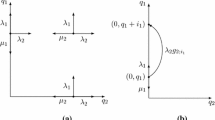Abstract
We consider a system in which customers join upon arrival the shortest of two single-server queues. The interarrival times between customers are Erlang distributed and the service times of both servers are exponentially distributed. Under these assumptions, this system gives rise to a Markov chain on a multi-layered quarter plane. For this Markov chain we derive the equilibrium distribution using the compensation approach. The expression for the equilibrium distribution matches and refines tail asymptotics obtained earlier in the literature.





Similar content being viewed by others
References
Adan, I.J.B.F.: A compensation approach for queueing problems. PhD dissertation, Technische Universiteit Eindhoven, Eindhoven (1991)
Adan, I.J.B.F., Wessels, J., Zijm, W.H.M.: Analysis of the symmetric shortest queue problem. Commun. Stat., Stoch. Models 6(4), 691–713 (1990)
Adan, I.J.B.F., Wessels, J., Zijm, W.H.M.: Analysis of the asymmetric shortest queue problem. Queueing Syst. 9(1), 1–58 (1991)
Adan, I.J.B.F., Wessels, J., Zijm, W.H.M.: A compensation approach for two-dimensional Markov processes. Adv. Appl. Probab. 25(4), 783–817 (1993)
Cohen, J.W., Boxma, O.J.: Boundary Value Problems in Queueing System Analysis. North-Holland, Amsterdam (1983)
Fayolle, G., Iasnogorodski, R., Malyshev, V.: Random Walks in the Quarter Plane. Springer, Berlin (1999)
Foss, S.G., Chernova, N.I.: On optimality of FCFS discipline in multi-channel queueing systems and networks. Sib. Math. J. 42, 372–385 (2001)
Haight, F.A.: Two queues in parallel. Biometrika 45(3–4), 401–410 (1958)
Kingman, J.F.C.: Two similar queues in parallel. Ann. Math. Stat. 32(4), 1314–1323 (1961)
Liu, Z., Nain, P., Towsley, D.: Sample path methods in the control of queues. Queueing Syst. 21, 293–335 (1995)
Marden, M.: Kakeya’s problem on the zeros of the derivative of a polynomial. Trans. Am. Math. Soc. 45(3), 355–368 (1939)
Miyazawa, M.: Light tail asymptotics in multidimensional reflecting processes for queueing networks. Top. doi:10.1007/s11750-011-0179-7 (2011)
Sakuma, Y., Miyazawa, M., Zhao, Y.Q.: Decay rate for the PH/M/2 queue with shortest queue discipline. Queueing Syst. 53, 189–201 (2006)
Author information
Authors and Affiliations
Corresponding author
Appendix
Appendix
In what follows we will assume that the α’s are in absolute value smaller than or equal to the starting solution σ 2, with σ the unique root of Eq. (3.4) in (0,1). However, for 0<ρ<1 one can easily verify that σ<ρ, so we will assume that |α|<ρ 2.
Lemma 7.1
For ρ<1 and for every α, with |α|∈(0,ρ 2), the equation det(D(α,β))=0 assumes the form

and has exactly k simple roots in the β-plane with 0<|β|<|α|/2.
Proof
Equation (7.1) is a polynomial in β of degree 2k and we will show that exactly k roots are inside the open circle of radius |α|/2. We divide both sides of Eq. (7.1) by α k+1 and set z=β/α which gives

with f 1(z)=2(kρ+1)z−αz 2−1. Then f 1(z) has two roots:

For 0<ρ<1, we observe that z + is located outside the open unit circle, while

Furthermore, for |z|=1/2,

Hence, by Rouché’s theorem \(f_{1}^{k}(z)-(2k\rho)^{k} z^{k+1}\) has exactly k roots inside |z|=1/2, which completes the proof. □
According to Lemma 7.1 all β roots are located in the open circle with radius ρ 2/2, so we assume that |β|<ρ 2/2.
Lemma 7.2
For ρ<1 and for every β, with |β|∈(0,ρ 2/2), the equation det(D(α,β))=0 assumes the form

and has exactly one root in the α-plane with 0<|α|<3|β|/4.
Proof
Equation (7.3) is a polynomial in α of degree k+1 and we will show that there is only one root inside the open circle of radius 3|α|/4. We divide both sides of Eq. (7.3) by β k+1 and set x=α/β, which gives

with f 2(x)=x(2kρ+2−β−x)k. Then f 2(x) has the zero root of multiplicity one and the root 2kρ+2−β of multiplicity k larger than the radius 3/4. Furthermore, for |x|=3/4,

Hence, by Rouché’s theorem f 2(x)−(2kρ)k has exactly one root in |x|<3/4, which completes the proof. □
Rights and permissions
About this article
Cite this article
Adan, I.J.B.F., Kapodistria, S. & van Leeuwaarden, J.S.H. Erlang arrivals joining the shorter queue. Queueing Syst 74, 273–302 (2013). https://doi.org/10.1007/s11134-012-9324-8
Received:
Revised:
Published:
Issue Date:
DOI: https://doi.org/10.1007/s11134-012-9324-8




